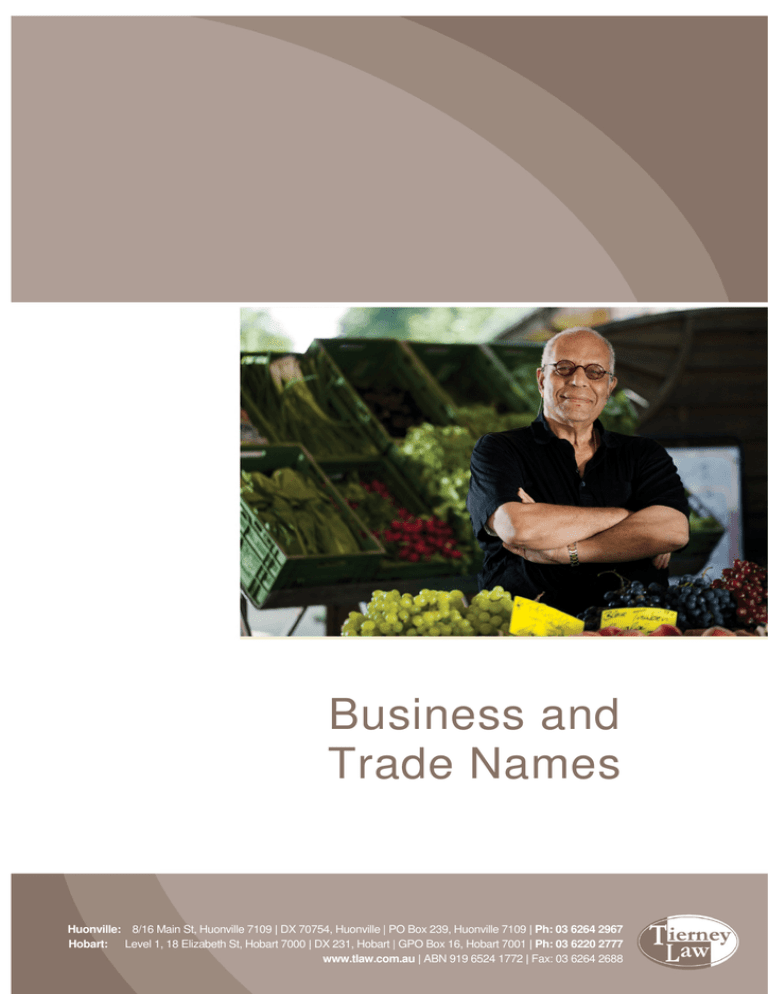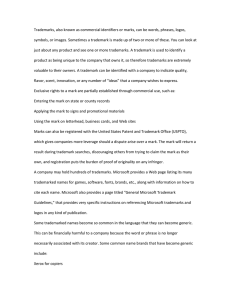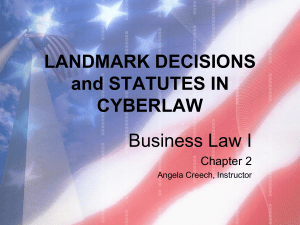Business and Trade Names Guide
advertisement

Business and Trade Names Huonville: 8/16 Main St, Huonville 7109 | DX 70754, Huonville | PO Box 239, Huonville 7109 | Ph: 03 6264 2967 Hobart: Level 1, 18 Elizabeth St, Hobart 7000 | DX 231, Hobart | GPO Box 16, Hobart 7001 | Ph: 03 6220 2777 www.tlaw.com.au | ABN 919 6524 1772 | Fax: 03 6264 2688 Contents BUSINESS NAME REGISTRATION ................................................................................................................................ 2 SOURCES OF UNREGISTERED TRADING NAME RIGHTS ....................................................................................... 2 REGISTERED TRADEMARKS......................................................................................................................................... 2 Applying to register; from "TM" to "®" .............................................................................................................................. 4 Is there any protection without registration?........................................................................................................................ 4 Rights to a registered trade mark can be lost ....................................................................................................................... 4 The commercial benefits of a registered trade mark ............................................................................................................ 5 The disadvantages of not registering ................................................................................................................................... 5 Domain Names ..................................................................................................................................................................... 6 −1− BUSINESS NAME REGISTRATION Business Name registration is a State Government licensing system. A business name must be licensed where a person whether natural or a corporate, carries on business under a name other than their own. The business name regime is essentially a tracking system to identify the legal person behind the trading name. It is not an approval system and like the registration of a company name, does not confer ownership or an enforceable rights upon the person registered. If the operator of the business will be using name other than it own to describe itself when trading, it will need to obtain a license to use that name under the business name registration system. A business descriptor is not necessarily a business name. You are not required to register a trade slogan if it in not the business name. If a business consistently uses the operators own name to identify the owner of the business they may be able to use a descriptive slogan without it being registered as a business name. Registration of the business name may be a good investment notwithstanding. The business name registration system licenses on a State by State basis and if there is to be trading in several States, registration in each State will be needed. SOURCES OF UNREGISTERED TRADING NAME RIGHTS A person can acquire rights in respect of a trading name just by using it. If a company, business or other name has a sufficient reputation attaching to it, the owner of that name may be able to prevent another person using a similar name because the use is likely to mislead or damage the business of the person with the existing reputation. These rights are often called “common law trademarks”. Sections 52 & 53 of the Trade Practices Act outlaw misleading and deceptive conduct. This is a further and broader basis upon which a person can prevent another person entering into a market with a similar name or mark. There is not a register of these common law rights that can be checked before starting to use a new name. A knowledge of the names and marks used in the relevant industry is extremely valuable. A search of the Company and Business Name Registers is a useful indicator, but not a definitive guide. REGISTERED TRADEMARKS −2− Registered trademarks are a source of extremely powerful rights. The Trademarks Act provides for a register of trademarks available to the public. A person with a valid trademark registration has an exclusive right to prevent another person using a name if: 1. that person uses a name as a trademark; 2. that person uses the name in relation to goods or services covered by the trademark registration; or 3. the name is deceptively similar to the registered trademark. The trademark owner can enforce these rights by an injunction restraining use of a similar name or mark and claiming damages or an account for profits. Two marks or names will be deceptively similar if their concurrent use is likely to cause confusion. Even if consumers merely wonder whether the goods or services bearing the marks or names might originate from the same source, this may be enough. Proof of deception is not required. For instance, the following names have been found deceptively similar: • “MOO and MOOVE”, • “CATERPILLAR” and “WILLOUGHBY’S CATERPILLAR LOADER HIRE SERVICE”, • “ARISTOC” and “RYSTA” Where the name involves elements of design or shape, copyright and registered designs might also protect a name. Before adopting a name, proper searches should be undertaken to see whether it is available. These may include business name and Securities Commission searches, trademark register searches, and more general reviews of the market, including for instance, search of the electronic databases of Yellow Pages and the Internet more generally. The Registrar of Trademarks can be searched via the Internet (www.ipaustralia.gov.au) or at an office of the Federal Government’s intellectual property department called IP Australia. There is no charge for these services. IP Australia’s trademarks office and other service providers also offer professional search services. −3− Beyond checking the existence of names that are similar or the same, you need to review the nature and extent of the usage of such names to see whether some conflict is likely. Do not rely solely upon a search of the Federal Trade Marks Office Databank . There is no obligation to register a trade mark in Australia Valid rights to a trade mark may exist at common law without appearing in the Federal Trade Mark Databank. A name may be available for use as a trading name but infringe trade mark rights be they pending, registered, or common law. Applying to register; from "TM" to "®" To apply, your application is lodged with the Trade Marks Office in IP Australia. Your application needs: • • to include a ''representation™ fa copy) of the trade mark; and to specify the goods and services for which you want the mark registered. If your trade mark is not registered (or while your application is being processed), you can place the letters "TM" beside the mark each time it appears. This claims your use of the mark. After registration, you can use the symbol"®" to indicate that you have the exclusive right to use the trade mark. Is there any protection without registration? Although you can try to protect a mark that is not registered, doing so is risky and is likely to be expensive — you must prove that the mark had a "substantial reputation" in a given commercial context. Rights to a registered trade mark can be lost Registration is not the end of it. Your registration of the mark can be lost if: • • • • it is not used in good faith for a continuous period of 3 years; or it becomes descriptive or generic (hence the need to choose something distinctive); or the renewal fees are not paid every 10 years; or registration is cancelled. −4− Some examples of previously registered trade marks which have lost their distinctiveness over time and become descriptive of the product itself, include 'linoleum", "escalator", "aspirin", "nylon" and "gramophone". A good test can be applied to determine whether a trade mark has lost its distinctiveness: think of a sentence that uses the mark, then see if the sentence makes sense without the mark. The commercial benefits of a registered trade mark Although registration of a trade mark is not compulsory, it is highly advisable. This is because registration: • • • • • • • • grants the owner a monopoly of rights to exclusively use. license or sell the trade mark within Australia for the relevant goods and services. can stop other traders from, and deter new business competitors from, using the same or a similar trade mark in relation to the relevant goods and services for which it is registered. of a trade mark can create a key marketing tool, as the public will identify a distinct quality and image with the relevant goods and services. helps to protect the reputation and goodwill the business has developed, as an intangible commercial asset, a registered trade mark can provide companies with financial leverage. provides a cheap and expeditious way of enforcing protection against acts of infringement by other traders. can last indefinitely (as long as it continues to be used, and is renewed every 10 years). confers legal rights on the owner with respect to the use of the trade mark — on the other hand, mere registration of a business name, company name or domain name does not, in itself, confer legal rights. The disadvantages of not registering The main disadvantages of not registering your mark are: • • that your competitors may register the same, or a similar, trade mark: and that if another person uses your mark, then you may have to sue (for example, for "passing off" or under the Trade Practices Act 1974): this is a −5− decidedly more complex and expensive task than suing for infringement of a registered trade mark. A trade mark may be deregistered if: • • • • • the mark becomes too descriptive or generic; someone applies to have it removed because it is not being used; the registration renewal fees are not paid; or registration is cancelled. To be registerable your trade mark must be capable of distinguishing your goods or services from those of another trader. Domain Names Addresses on the internet are based on computer numbers to which names are assigned for ease of access. Each computer address must be unique and a registration system keeps the allocated names unique. There are a variety of types of names and registering bodies. Those bodies set their own rules that generally are subject to general principles of law and naming rights. Check the availability of your trade name as a domain name. Consider securing your trade name as a domain name. −6−


